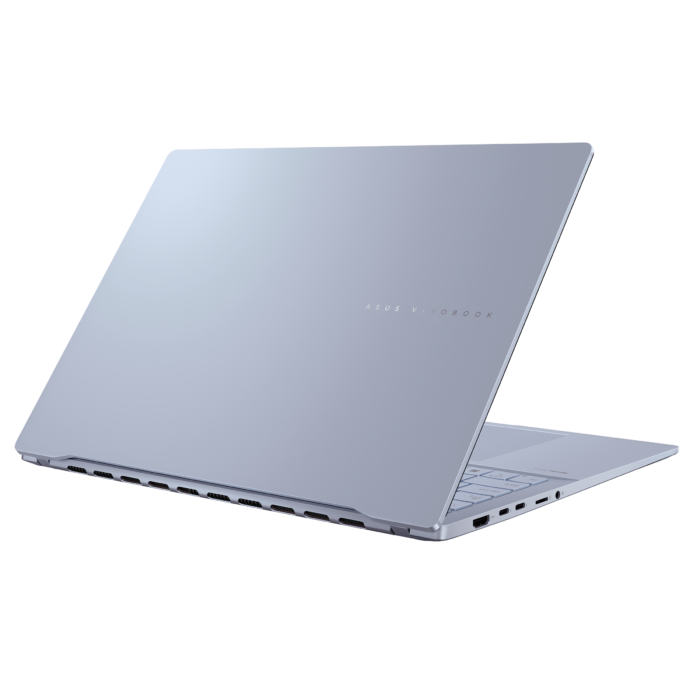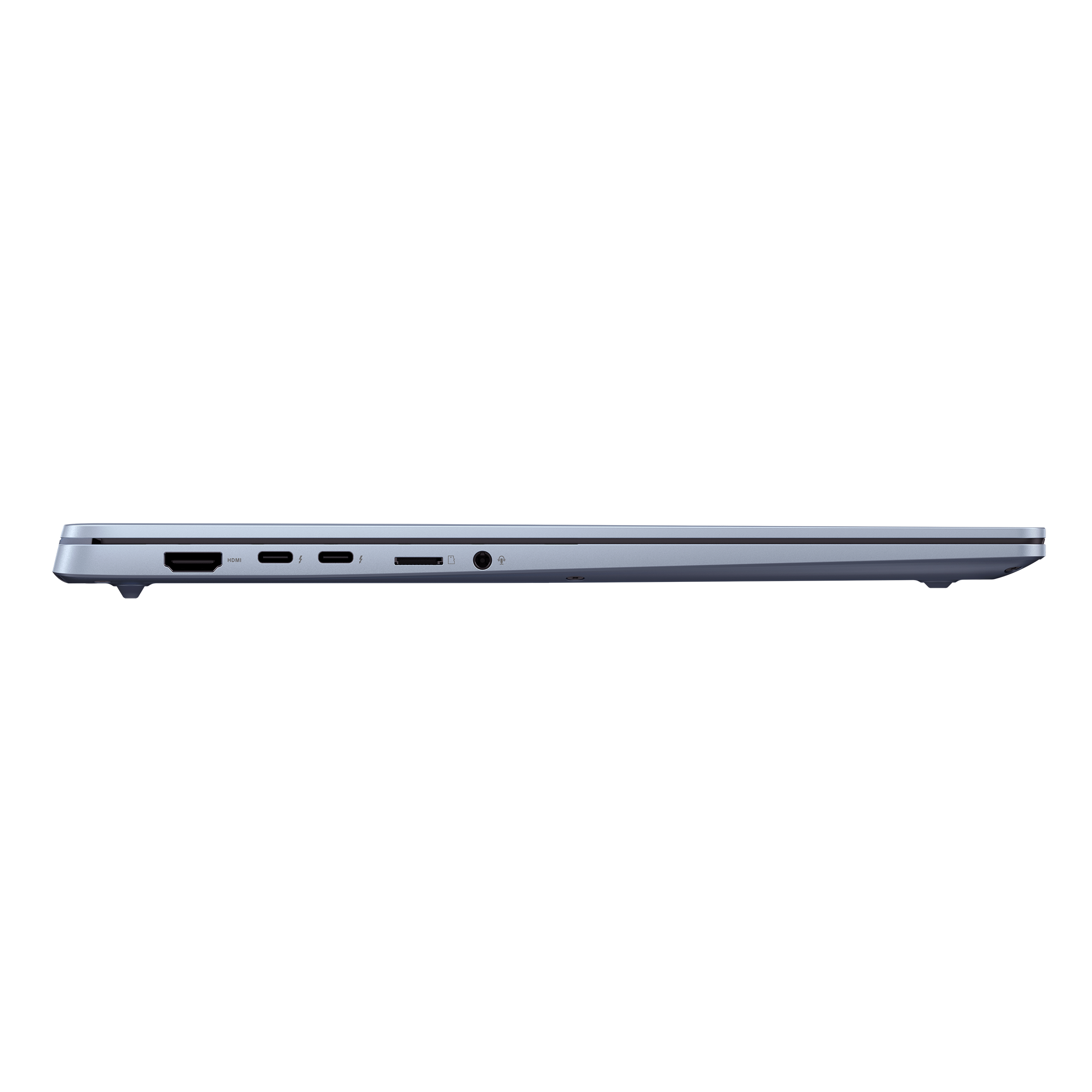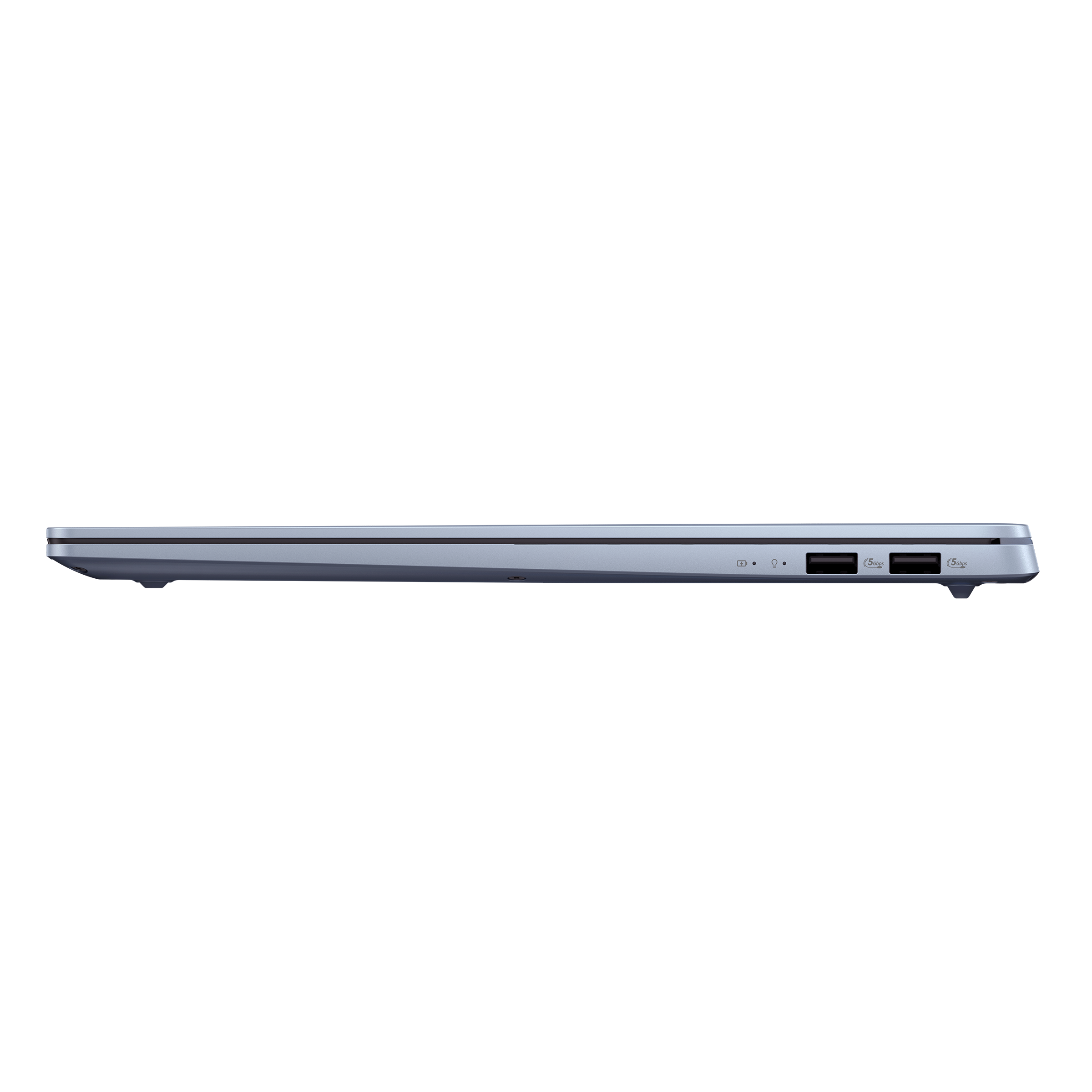The laptop we are reviewing belongs to Asus’ Vivobook series. The series usually consists of business laptops, but some are gaming laptops. In the past, we’ve reviewed two gaming laptops in the series: the Asus Vivobook Pro 15 OLED and the Asus Vivobook Pro 16X OLED.
Asus recently updated its Vivobook lineup with a new Intel Core Ultra series chipset. The laptop we reviewed is the new Asus Vivobook S 15 OLED, which is powered by the Intel Core Ultra 5 125H chipset. This laptop also has higher processor options,
Specifications
| Screen | 15.6-inch, 3K (2880 x 1620) OLED, 16:9, 120Hz, 400 nits, 100% DCI-P3, 1,000,000:1, VESA certified Display HDR True Black 600, 1.07 billion colors, Glossy, 70% less harmful blue light, TÜV Rheinland-certified, Non-touch, (Screen-to-body ratio) 83% |
| Processor | Intel Core Ultra 5 Processor 125H 1.2 GHz (18MB Cache, up to 4.5 GHz, 14 cores, 18 Threads); Intel AI Boost NPU |
| Wireless Connection | Wi-Fi 6E (802.11ax) (Dual band) 2 x 2 wireless card, Bluetooth 5.3 |
| Graphics card | Intel Arc Graphics |
| Memory | 32GB LPDDR5X on board, up to 32GB |
| Storage | 1TB M.2 NVMe PCIe 4.0 SSD |
| Ports | 2x USB 3.2 Gen 1 Type-A 2x Thunderbolt 4 1x HDMI 2.1 1x 3.5mm Audio Jack 1x Micro SD card reader |
| Battery | 75Wh, 4S1P, 4-cell Li-ion battery with Type-C 90W AC adapter |
| OS | Windows 11 Home |
| Weight | 1.50 kg (3.31 lbs) |
Design

The new Asus Vivobook S 15 OLED S5506 is available in two colors: Neutral Black and Mist Blue. The one we are reviewing is in blue. The dimensions of this laptop are 353.6 x 246.9 x 15.9 mm, and it weighs 1.5 kg. There is no doubt that the competitor model weighs less (around 1.1-1.2 kg), but the overall portability of the Vivobook S 15 OLED is still excellent.
The laptop also supports 180-degree opening, allowing users to use it from different angles. It is certified to the MIL-STD 810H military-grade standard, ensuring exceptional durability even in challenging conditions.

Its body is made of metal, enhancing its premium feel. The display housing has a cleaner design compared to its predecessor, with the Asus Vivobook’s branding engraved on the display case in a small font, while the previous generation used an embossed logo nameplate.
Display

It comes with a 15.6-inch OLED glossy display. It has a 16:9 aspect ratio and an 83% screen-to-body ratio. It supports a 2880×1620 resolution, a 120Hz refresh rate, 400 nits of brightness, and a billion colors. Additionally, the response time is only 0.2 ms, and the contrast ratio is 1,000,000:1. According to official claims, the display covers 100% of the DCI-P3 color gamut. It is also SGS certified for eye protection and TÜV Rheinland certified to reduce harmful blue light by 70%.
A full-HD camera sensor is integrated into the top bezel of the display and supports Windows Hello, allowing you to quickly and securely unlock your laptop. It also features a privacy shutter that allows you to block the camera when not in use.
In our screen benchmarks, we used the Spyder X. We found that in DCI-P3 color mode, this display covers 99.8% of the sRGB, 95.2% of the AdobeRGB, and 98.8% of the DCI-P3 color gamuts. The peak brightness measured in SDR mode is 362 nits, and in HDR mode it is 579 nits, which is slightly lower than the official claim.
We also tested color accuracy in all three modes (sRGB, DCI-P3, and Display-P3). In sRGB mode, the measured average Delta-E value was 0.8 (peak value was 2.85). In Display-P3 mode, the average value was 0.78, while the peak was 2.62. In DCI-P3 color mode, the average measured value was 0.93, while the peak was 2.95.
Keyboard and TouchPad
This laptop comes with a full-size Chiclet keyboard with 1-zone RGB backlighting (support for millions of custom colors and Microsoft Dynamic Lightning effect settings). Such a feature may not seem common for business laptops, but it may appeal to specific users. The keyboard also has a small numeric keypad, which is a pleasant surprise for business users. The keyboard boasts an extra-long key travel of 1.7mm and a concave curved keycap design of 0.2mm.

With Windows Dynamic Lighting, users can easily adjust colors, modes, and brightness levels directly in Windows settings to enhance the appearance of their keyboard. The lighting style can be changed from static (solid mode) to dynamic modes, such as breathing and rainbow mode.
Below the keyboard, we see an oversized 7.1-inch touchpad, the largest in ASUS laptop history. It is officially stated that its size has increased by 40% compared to the previous model. The touchpad supports an ultra-high 240Hz sampling rate, ensuring a smooth drag experience without lag.
Ports
The Asus Vivobook S 15 OLED S5506 has seven ports, which are enough for users’ daily office needs. On the left side, there is an HDMI 2.1 TMDS port, 2 USB Type-C Thunderbolt 4 ports (supports DisplayPort and Power Delivery), a MicroSD card reader, and a 3.5mm headphone jack. On the right side, there are two USB Type-A Gen 3.2 ports that support transfer speeds of up to 5 Gbps.
The laptop lacks an RJ45 port, but it is not a must-have port for laptops these days. With these enough ports, we are sure that users do not need to connect any external dock for added connectivity.
Also Read: Dell Inspiron 14 Plus 7440 Review (Intel Core Ultra 7-155H)
Battery and Charging
The Asus Vivobook S 15 OLED S5506 comes with a 75Wh 4-cell Li-ion battery. The battery has a 20% increase in charge cycles and can retain more than 75% of its capacity after four years. According to official claims, the battery can last up to 16 hours at medium settings.
The company offers a 90W USB Type-C AC adapter. Asus claims that it can charge the battery to 60% in just 49 minutes.
We used the PCMark 10 Modern Office to conduct the battery testing. Before testing, we configured the performance mode to “Best Energy Efficiency”, adjusted the fan mode to “Quiet Mode”, and set the screen brightness to 50%. With these settings, we achieved 13 hours and 20 minutes of battery life with only 2% battery remaining.
RAM and SSD
The Asus Vivobook S 15 OLED S5506 has two memory options: 16GB and 32GB. The laptop we reviewed is equipped with 32GB of LPDDR5x dual-channel memory (2x 16GB memory modules at 7467 MHz). It is soldered to the motherboard, so the memory cannot be upgraded.
We also benchmarked it with AIDA64. Once the tests were completed, we got the following results: 74,882 MB/s read, 72,228 MB/s write, 90,795 MB/s copy, and a latency rate of 134.8 ns. The results are quite good.
In the storage section, the manufacturer offers two options again: 512GB and 1TB. Our laptop has a 1TB SSD. Since it has only one SSD slot, users need to replace their existing SSD to expand storage space.
To test the SSD, we used CrystalDiskMark software, and the results were as follows: 5,011.26 MB/s for sequential read, 3,439.87 MB/s for sequential write, 68.43 MB/s for 4K random read, and 162.73 MB/s for 4K random write. In this section, the Asus Vivobook S 15 OLED performs well.
CPU Benchmarks
The Asus S5506 is available with three CPU options: Intel Core Ultra 5, Core Ultra 7, and Core Ultra 9. The one we have is powered by Intel Core Ultra 5 125H. The CPU consists of a total of 14 cores, including 4 P-cores (base frequency: 1.2 GHz, peak frequency: 4.5 GHz), 8 E-cores (base frequency: 700 MHz, peak frequency: 3.6 GHz), and 2 LP E-cores (base frequency: 700 MHz, maximum frequency: 2.5 GHz). The CPU has 18 threads and 18MB of L3 Intel Smart Cache. The CPU has a TDP of 50W.
The significant advantage of using two LP E-Cores is that they are responsible for video decoding and playback. They can completely shut down all cores and other unused module units in the computing module, resulting in ultra-low power consumption. Here are the benchmark results for the Intel Core Ultra 5-125H CPU:
CPU-Z: 748 on Single-Core and 6,441 on Multi-Core
Cinebench R15: 242 on Single-Core and 2,153 on Multi-Core
Cinebench R20: 643 on Single-Core and 5,281 on Multi-Core
Cinebench R23: 1,709 on Single-Core and 13,918 on Multi-Core
Cinebench 2024: 99 on Single-Core and 820 on Multi-Core
This test was conducted in Best Performance Mode, with the fan mode set to maximum speed for optimal CPU performance. We also compared the Core Ultra 5 125 to the Core i5-13500H CPU and found that the difference between the two is very small.
|
Intel Core i5-13500H at 58W TDP (IdeaPad Pro 5 14IRH8) |
Intel Core Ultra 5-125H at 54W TDP (Vivobook S 15 OLED S5506) |
|
|
Cinebench R15 Single-Core |
253cb |
242cb |
|
Cinebench R15 Multi-Core |
2,197cb |
2,153cb |
|
Cinebench R20 Single-Core |
633cb |
643cb |
|
Cinebench R20 Multi-Core |
5,433cb |
5,281cb |
|
Cinebench R23 Single-Core |
1,726pts |
1,709pts |
|
Cinebench R23 Multi-Core |
14,332pts |
13,918pts |
GPU Benchmarks
The Asus Vivobook S 15 OLED S5506 does not have a discrete GPU, but it comes with an Intel Arc GPU. Here are the benchmark results for the GPU:
3DMark Time Spy: 3,879 total score, including 3,521 GPU score
3DMark Fire Strike Extreme: 4,305 total score, including 4,319 GPU score
Heat Dissipation and Stress Testing:
This laptop features IceCool cooling technology, which includes two heat pipes and dual fans. Additionally, it is worth noting that both fans are equipped with dust filters that prevent dust and fibers from entering the interior of the laptop, thereby improving its longevity and performance.
CPU Stress Test: This test is conducted using AIDA64 FPU mode. After almost 10 minutes, the power consumption rises to 54W, and the core temperature is 95°C. The P-core frequency is 4.0GHz, the E-core frequency is 2.81GHz, and the LP E-core frequency is 2.31GHz.
Summary:
The Intel Core Ultra 5 125H offers efficient processing power, while the integrated Intel Arc GPU delivers impressive graphics performance that outperforms some discrete graphics cards in benchmarks. IceCool cooling technology ensures efficient heat dissipation to maintain optimal performance under high loads. Overall, the Asus Vivobook S 15 OLED S5506 excels in terms of design, display quality, performance, and battery life. It is a compelling choice for users seeking a versatile, high-performance laptop for both work and play.
The variant we reviewed costs $830, which is a great value for money. However, for those on a tight budget who are willing to compromise on memory and storage capacity, there are also options available in 16GB RAM and 512GB storage configurations. However, for users looking for more powerful performance, there are variants with Intel Core Ultra 7 and Intel Core Ultra 9 CPUs available.

